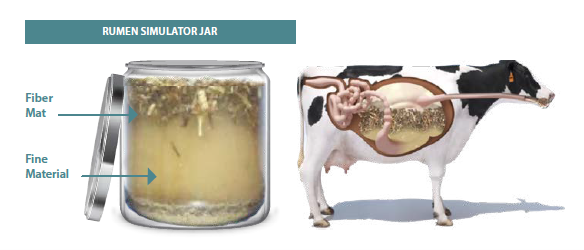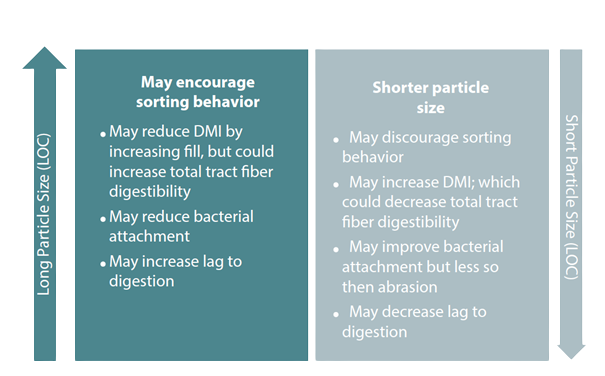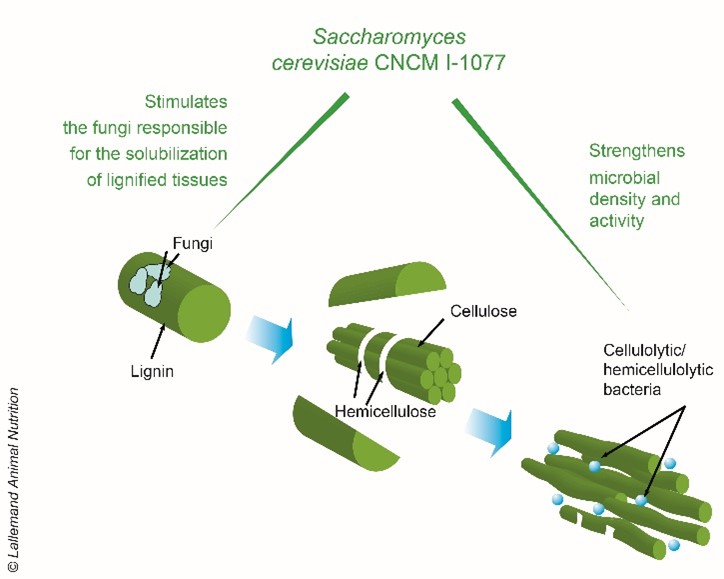Blog | Reading Time 6 minutes
Do you know how fiber is affecting rumen health?
Ruminant digestive systems have the ability to degrade and ferment fiber through microbial activity. The fiber components, and the subsequent production of volatile fatty acids (VFAs), provide the majority of the energy for the ruminant. But energy (and milk) production is not the only role of fiber: it is the fiber that ensures the proper function of the rumen. Hence the quality and properties of fiber is a key element to ensure optimal rumen function and rumen health to preserve cows’ well-being.
Understanding fiber degradation
Fiber is slowly degraded in the rumen due to its physical structure and the lignin cross-linking that holds the fiber intact. Fiber degradation in the rumen is influenced by:
- The anatomy of the fiber (pectin, hemicellulose and cellulose concentration), which is related to crop species
- Lignin content and structure (maturity, species, stressors, etc.)
- Particle size
- Passage rate (highly influenced by particle size, uNDF, DMI) and its impact on rumen dynamics
- Cud-chewing and ruminal contractions
- Rumen microbial population (microbiome) influenced by several factors (e.g. diet, environment)
The rumen mat
First of all, fiber plays a physical role in functioning of the rumen engine. The rumen content is composed of several layers:
- Gazes at the top
- The fiber mat floating over the liquid
- Fine material mixed into the liquid

Figure 1: Representation of the rumen fiber mat
The rumen fiber mat helps stimulate rumen muscular dynamics by moving the rumen wall with contractions every 35 to 45 seconds. This, in turn, moves and intimately mixes the rumen digesta, which mixes and dilutes out local concentrations of VFAs. This aids VFA absorption at the rumen wall, moves out gas pockets, aids regurgitation (cud chewing) and helps propel smaller particles of rumen digesta to the abomasum.
Not all fibers are made equal
When it comes to the rumen mat, the characteristics of the fiber, hence the source of the plant material have different impact on fiber mat quality (table 1).
|
What makes a good fiber mat? |
What makes a poor fiber mat? |
|---|---|
|
Dry hay (floats) |
Wet haylage |
|
Chopped straw (floats) |
Fine forages |
|
Dry haylage |
Beet pulp, ground soyhulls |
|
> 16 mm corn silage |
Wet brewers grain |
Table 1: What makes a good:poor fiber mat.
Particle size and rumen health
The length of cut at harvest, which determines particle size, also plays a crucial role on the function of the rumen mat (Figure 2).
If the particle size is too long, this may encourage sorting behavior; which could lead to rumen dysfunction and an increase in the incidence of Sub Acute Ruminal Acidosis (SARA).
Cows have been shown to preferentially select for the grain component of a TMR and against the longer forage components. The sorting of TMR can result in the ration actually consumed being greater in fermentable carbohydrates (thus more acid lactic is produced) than intended, and lesser in effective fiber, thereby increasing the risk of SARA.
Moreover, longer particles could reduce dry matter intake (DMI) by increasing rumen fill and limiting passage rate. This longer time enables rumen fibrolytic microbiota to better digest the fiber, increasing total tract fiber digestibility.
On the other side of the spectrum, diets with reduced particle size could reduce chewing activity, saliva production and rumen buffering, and this can result in rumen pH depression similar to grain-induced SARA. In a classic acidosis study (Khafipour, 2009), researchers replaced chopped alfalfa hay (coarse material) with alfalfa pellets (fine material) to induce low pH in the rumen without any changes in the starch content or in forage:concentrate (F:C) ratio of the diets. The research concluded that a rumen pH depression typical of SARA (at least 180 minutes/day of pH < 5.6) was created by increasing the dietary content of pelleted forage without changing the F:C ratio and dietary starch content. uNDF240h represents an interesting criterion to assess the physical role of fiber.

Figure 2: Effect of particle size on rumen function
Fiber value evaluation: size matters!
The physically effective fiber (peNDF) is defined as the fraction of fiber that stimulates chewing and contributes to the floating mat of large particles in the rumen (Grant and Contach, 2005). Penn State University dairy researchers recommend that 60-70 % of the NDF content of the TMR should be considered physically effective or 21-23% of DMI as peNDF (Mertens, 1997). In practice, the peNDF is the proportion of particle retained by sieves with diameters above 4mm. New concept appears with the inclusion of the information related to the rumen degradation. This peuNDF240 (physically effective undigested aNDFom after 240 hours of incubation) encompasses information related to the physical aspect (“pe”) and degradation (“uNDF240”) seems to be a good predictor of rumen fill and then dry matter intake.
How is it evaluated?
- In the field: The Penn State Particle Separator method uses the three-screen plus pan – 19 mm screen/8 mm screen/4 mm screen/bottom pan for on-farm assessment
- In-lab: Ro-Tap. The Mertens (2005) Ro-Tap Particle Size procedure uses specific sieve sizes of 19.0, 13.2, 9.5, 6.7, 4.75, 3.35, 2.36, 1.18, 0.60, and 0.30 mm with a 10- minute operation time on dried material in a Ro-Tap machine. The amount above 1.18 mm is used to calculate peNDF for on-lab analysis.

Rumen modifier: complementary tool to secure rumen health
Rumen modifier feed additives, such as the specific live yeast Saccharomyces cerevisiae CNCM I-1077 (LEVUCELL SC) have the ability to help control the rumen environment and microbial ecosystems, leading to stabilization of ruminal pH, and increase in fiber degradation. Combined to optimal fiber quality and structure, they contribute to maintain rumen health.
The mechanism of action of S. cerevisiae CNCM I-1077 on fiber degrading activities is based on stimulating and encouraging the colonization of specific rumen bacteria and fungi and promoting substrate access. Since a huge portion of the rumen cellulolytic flora is considered as strictly anaerobic. Oxygen scavenging by live yeast in the rumen is an advanced mode of action for higher fibrolytic activity (Figure 3).

Figure 3: A proposed scheme for mode of action of S. cerevisiae CNCM I-1077 on fiber degrading communities (Chaucheyras- Durand et al, 2016).
References
Khafipour, E., D. O. Krause, and J. C. Plaizier. 2009. Alfalfa pellet-induced subacute ruminal acidosis in dairy cows increases bacterial endotoxin in the rumen without causing inflammation. J. Dairy Sci. 92:1712–1724.
Grant R. J. and Cotanch K. W. 2005. Physically Effective Fiber for Dairy Cows: Current. Prospectives. W. H. Miner Agricultural Research Institute, Chazy, NY.
Published Dec 2, 2022 | Updated Jun 5, 2023
Related articles
Need specific information?
Talk to an expert